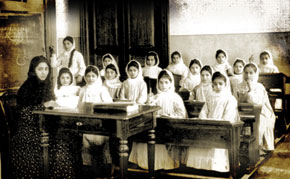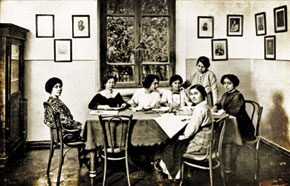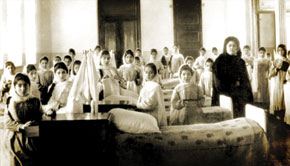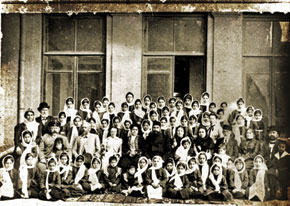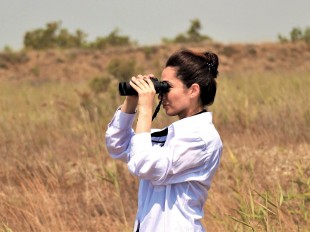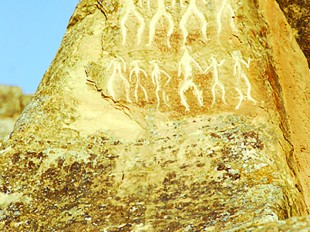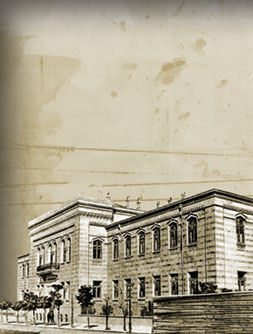 Haji Zeynalabdin Taghiyev was born into a poor family in Baku and began work as a bricklayer. He invested the money he managed to save in the most profitable business in the 1870-90s – oil. He was one of the first Azerbaijani oil entrepreneurs to establish a basis for the development of non-oil business from oil profits. His interests covered every sector of Azerbaijan’s economy; he invested in metallurgy, shipbuilding, energy, cotton, fishing, wine-making and communications, he owned large woodlands, was the founder of the Baku Merchant Bank and dealt in real estate.
Haji Zeynalabdin Taghiyev was born into a poor family in Baku and began work as a bricklayer. He invested the money he managed to save in the most profitable business in the 1870-90s – oil. He was one of the first Azerbaijani oil entrepreneurs to establish a basis for the development of non-oil business from oil profits. His interests covered every sector of Azerbaijan’s economy; he invested in metallurgy, shipbuilding, energy, cotton, fishing, wine-making and communications, he owned large woodlands, was the founder of the Baku Merchant Bank and dealt in real estate. He was not only a successful entrepreneur; he was also a great public figure. He was repeatedly elected to the Baku Duma and was involved in many civic projects, particularly in financing the construction of a horse-drawn tramline and the Baku-Shollar water pipeline. He constructed the first theatre building in Baku, in 1883.
Taghiyev sponsored the founding of educational institutions in Baku, Ganja, Shemakha and Nakhchivan as well as beyond the borders – in Tiflis, Derbend, Vladikavkaz and other cities. He was honorary patron of Baku’s secondary technical school, the School of Commerce and the Mariinsky Women’s Gymnasium and was honorary supervisor of the Muslim School in Tiflis.
Educated girl, educated mother, educated family
He wrote From my Experience in the Teze Heyat (New Life) newspaper of 12 February 1908:
… when I was poor, I did not receive anything from my parents except for love and hugs and I think that my present condition is due to the love and hugs they gave me. I cannot explain whether it is just luck or a blessing from Allah, but I love and cherish my nation, its happiness and future existence as much as industry and business, even more so. The one thing that I believe is important for that future is the upbringing and education of my people… Recognising the necessity of opening schools to educate and raise young children and the importance of publishing books and newspapers for the education and development of adults, I attended to these issues and will do so in the future.
Taghiyev was concerned about Muslim women’s closed lives and their ignorance of their rights. He dearly wished them to be educated, cultured and broad-minded. He believed that an uneducated and oppressed woman was also an uneducated mother. He often asked: What can such a woman give to her child? He was certain that enlightenment should begin with girls, thus the enlightenment of a child results in an educated individual, however, an educated girl means an educated mother and an educated family in the future. That is why he sent his daughters Leyla and Sara khanim to study for a higher education in Petersburg.
The first steps...
towards women’s education were taken in the first half of the 19th century. In 1848, St. Nina’s secular Russian school was opened in Shemakha (it was later moved to Baku). In 1874, the first gymnasium in Baku opened; it offered secondary education, however, few Azerbaijanis attended. At the end of the 19th century there were 1,283 girls studying in all the country’s secondary schools (including pro-gymnasiums) and only 6 of them were Azerbaijani. This woeful state of affairs alarmed those intellectuals concerned for the fate of the nation and its people. Political essayist and public figure Mammadaga Shakhtakhtinski wrote:
Women’s education… would provide elementary general knowledge and rescue the Muslim world from difficult social problems, because women have closed lives. The absence of the activity and liberty necessary to physical and mental health in this life makes them spoilt and helpless, thin, unhealthy and feeble. Of course, mothers pass on their shortcomings to their daughters and even to their sons.
...in 1895
Azerbaijani intellectuals not only raised the question of secular education for girls, they also took practical steps to achieve it. Thus, on 19 January 1895, the great pedagogue and enlightener Hasan bey Zardabi applied to the Governor of Baku with a request to open a single-grade school for Muslim girls. He was quickly rebuffed.
2 months later – on 22 March 1895 – H.Z. Taghiyev received a letter from A.S. Tkhorevski, director of the People’s School of Baku province and Dagestan region. It said:
… You are well-known for your great philanthropy and enthusiasm for advancing people’s education, and that is why I apply to you with the following request:
1) In honour of the forthcoming event, a joy for the whole of Russia, the crowning of his Majesty the Emperor, we ask you to found a school for Muslim girls in Baku. The school shall conform to the one- or two-grade school courses of the People’s Ministry of Education; in accordance with the needs of the Muslim family, stitch work and housekeeping shall be taught there.
2) In the event that you agree to found a Baku school for Muslim girls which, for the present, would be the only one of its kind in the Empire, we wish this school to be called ‘Olginski’ in honour of the Emperor’s daughter, her Majesty Princess Olga. I ask you to respond as soon as possible in order that I may inform the Patron of the Caucasus Education District about your decision in good time.
Challenge accepted
Of course, this proposal had not come out of the blue and Tkhorevski’s letter was soon answered. One month later, on 24 April 1896, Taghiyev wrote to K.R. Yanovski, patron of the Caucasus Education District stating that he was ready to establish a secular Russian-Muslim school for girls. He said that he would observe the sacred crowning ceremony of His Majesty the Emperor with a charitable deed and had decided to establish the secular Russian-Muslim school for girls in Baku at his own expense. He mentioned that he would provide 25,000 roubles for the construction of the school building with all necessary services and conditions and would provide an additional 125,000 roubles as a donation from which the interest, 5,000 roubles, could be used for school maintenance. He hoped that the appropriate bodies would be able to obtain higher consent for naming the school after the Empress Aleksandra Fyodorovna. Although Yanovski agreed to Taghiyev’s plan, the opening of the school was delayed for a few years. State officials, religious figures and conservatives did all they could to obstruct the opening.
At the end of the 19th century there was ambivalence in Azerbaijani society about the education of women and great prudence and delicacy was important. In a letter to Shakhtakhtinski Taghiyev wrote:
… as a local person, I know Muslim family life and all its shortcomings very well. There is only one way to gradually help the Muslim woman out of the fanatically closed life that she currently lives, and this way is school and only school. But this school should be established and organized so skilfully that Muslims will respect it without reservation, trust it and send their daughters to study there.
The budding
Thus, in June 1898, construction began.
Finally, all the hard work bore fruit. On 16 May 1898, the school’s charter was approved. On 24 May 1898, the Empress gave her consent for the school to carry her name. In fact the cost of construction was higher than the 25,000 roubles originally allocated and Taghiyev’s expenses totalled 308,500, including 183,500 roubles for construction.
The chief architect of the school was Joseph Goslavski, of Polish origin. He skilfully incorporated the romantic traditions of Azerbaijani architecture and created a flexible and picturesque masterpiece. The school building, finished in April 1901, became one of the city’s sights.
The opening ceremony took place at 12.00 noon on 7 October 1901. Zardabi was happiest of all about the launch of this school in a festive atmosphere attended by many notables, including intellectuals, a great lawyer, a member of the Russian State Duma and the chief editor of the Kaspi newspaper. This editor, Alimardan bey Topchubashov, would go on to be a founder of the independent republic of 1918-1920 and he, too, supported Taghiyev’s scheme, stating that the opening of the school would be the start of a new era.
The news of the founding of the first school for noble-spirited Muslim girls in Baku spread far and wide. The monthly Kafkazski Vestnik (Caucasus News) magazine, the Caucasus newspaper published in Tiflis and newspapers and magazines published in Baku lavished praise and congratulations on the occasion. There were many letters of greeting: from Calcutta (India), Bakhchasaray (Crimea), Port-Petrovski (the present-day Makhachkala), Bukhara (Uzbekistan), Riga (Latvia) and other places where Muslims lived. 58 girls aged from 7 to 11 were enrolled in the school; 35 of them were from poor families and were excused education fees. Taghiyev paid for their clothing and food. Although the students came mainly from Shusha and Tiflis, some were from other regions of the Caucasus. The school’s academic year started on 1 September and ended on 14 March.
The nurturing
The benefactor himself was often at the school, inquiring from students about their lives, education and food. There were frequent medical checks of students’ teeth, hair, throats and ears.
A number of events were arranged for the effective use of the girls’ leisure time. Assisted and directed by Sona khanim (Taghiyev’s wife) and teacher Sakina Akhundzade, the girls staged N. Vezirov’s plays Out of the Pan into the Fire and You must Reap what you Sow, and U. Hajibeyov’s Arshin Mal Alan, taking the roles of both men and women.
There were also lessons in religion and dressmaking.
The school had a rich library, including the works of Azerbaijani, Russian and foreign classical writers such as Nizami, Fuzuli, Pushkin, Lermontov, Turgenev, Tolstoy, Shakespeare, Byron, Schiller, Moliere, Voltaire, Seyid Shirvani, Tewfiḳ Fikret, N.Kamal and others. Many magazines, including Molla Nasreddin, were delivered to the library.
The branching
In 1913 Taghiyev suggested transforming the school from a primary to a secondary educational institution, like the Mariinsky schools. He particularly emphasized the importance of teaching the Azerbaijani language at the newly established school. In the same year, he pushed for the opening of two-year pedagogical courses for Muslim women within the Aleksandrinski School. Both issues were resolved in April 1913, with Taghiyev donating 100,000 roubles. The pedagogical courses opened in 1915. Graduates from the courses worked as teachers in other Azerbaijani schools.
The school opened with four teachers – Hanifa khanim Abayeva (director), Maryam khanim Sulkevich (assistant director) and Asmat khanim Mammadamin Efendi gizi (teaching Shariah, native language, stitchwork and housekeeping) as well as Sakina khanim Akhundzade. It had seven teachers in 1908, there were eight in 1912-1913, and in 1915 eleven teachers were at work there. Most of them were in Baku at Taghiyev’s invitation, coming from Russia, Georgia, Lithuania, Uzbekistan, Dagestan and Tatarstan but linking their destiny to Azerbaijan.
The school was the dawning of secular education for Muslim girls. In 1901 a girls’ school was opened in Irevan, in 1902 in Ganja, in 1907 schools were opened in Nukha (now Sheki) and Eresh in the Yevlakh region, in 1909 a Russian-Azerbaijan girls’ school was opened in Baku. Later other girls’ schools were opened in Guba, Nakhchivan, Aghdam, Shusha, Shemakha and even in several villages, including Zayamda (Goychay district), Salahli (Gazakh district), Balakhani (Baku district). Most of their teachers were graduates from Taghiyev’s schools or the two-year pedagogical courses.
The blossoming
These early graduates were active in the social, political and cultural life of Azerbaijan, worked in party and other Soviet organisations, providing invaluable service to the development of education and health care, and playing important roles in fostering new generations. Among them were women like Sona Akhundova, mother of the great Azerbaijani composer Gara Garayev, Sugra Mirgasimova, mother of the psychiatrist Agabey Sultanov, Madina Garayeva, mother of children’s author Khanimana Alibeyli, Shafiga khanim Efendizadeh, mother of the great medical figure Fuad Efendiyev, after whom Hospital No 4 is named, and many others.
Tragically, the massacres of Azerbaijanis carried out by Bolsheviks and Armenian Dashnaks in March 1918 forced the school to close.
Thus we can see that Haji Zeynalabdin Taghiyev’s girls’ school was not simply an educational institution, it was truly a bridge to the assimilation of knowledge of contemporary world culture from religious and national traditions.
Bibliography
1. Suleymanov M. The Things I Heard, Saw and Read. Baku, 1990
2. State Literature and Art Archive of Azerbaijan Republic, p. 675
3. Jabbarov F. From the History of the Girls’ School of H.Z.Таgiyev. Baku, 2011
4. State History Archive of the Azerbaijan Republic, p. 309
5. Akhundov F. The Foundation of the Intelligent Nation – Intelligent Woman.
The Girls’ School of H.Z.Таgiyev. Baku, 2007
About the authors: Mais Amrahov is a PhD in History, Professor of the Department of the History of Turkic and Eastern European Nations and Methodology of History Education, Azerbaijan State Pedagogical University Garatel Gafarova is Head of the Exposition Department of the People’s Education Museum, Ministry of Education of the Azerbaijan Republic
